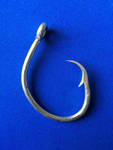Circle hooks are an effective conservation measure because they significantly reduce “gut hooking” that leads to discard mortality. The department also launched and is continuing to expand an
 educational outreach program
educational outreach program to assure compliance with these regulations.
What is a non-offset circle hook?
- Non-offset circle hooks are generally defined as a hook with the point turned perpendicularly back to the shank.
Benefits and techniques when using circle hooks
- Circle hooks are designed to hook fish in the corner of the mouth which makes the fish easier to release.
- Circle hooks have been used successfully with both dead and live baits for many species.
- Circle hooks are used with what anglers call a "dead stick" or still rod in a holder - anglers do not pull back hard on the fishing rod to set the hook, it is more of a finesse technique.
-
 Circle hooks have shown to reduce deep hooking of fish while J-hooks have a tendency to deep hook fish and puncture organs, which results in mortality.
Circle hooks have shown to reduce deep hooking of fish while J-hooks have a tendency to deep hook fish and puncture organs, which results in mortality. - Circle hooks can greatly increase the survivability of striped bass after
catch and release due to shorter de-hooking times and reduction of deep hooking.
- The general function of circle hooks is to hook fish in the corner of the mouth, resulting in fewer injuries to the fish and easier unhooking - this is already documented in department studies and in other states.
Regulations involving Hooks and Bait
The following rules apply to hooks and bait use in Maryland’s tidal waters.
- In the Chesapeake Bay and its tidal tributaries:
- Anglers must always use a non-offset circle hook when chumming;
- Anglers are generally required to use a non-offset circle hook when live-lining. Anglers can use either a non-offset circle hook or a J hook if they are not fishing for striped bass and one of the following exceptions applies:
- The angler is using a live finfish that is less than 4" in length (this exception does not apply to using white perch or spot as bait. When using white perch or spot while livelining, anglers must always use a non-offset circle hook); or
- The angler is using a mummichog, striped killifish, banded killifish, spottail shiner, golden shiner, rough silverside, silverside, anchovy or silvery minnow as bait (in which case the 4" maximum does not apply)
- From March 1 through May 15 when using fish, crabs or worms as bait or when using processed baits, while not live-lining or chumming, anglers must either use a:
- Non-offset circle hook, or
- J-Hook with a gap equal to or less than 1/2"
- From May 16 – December 31 when using fish, crabs or worms as bait or when using processed baits while not live-lining or chumming, anglers must:
- Use a non-offset circle hook when targeting striped bass, or
- Use either a non-offset circle hook or a J-hook when targeting species other than striped bass
- In the Atlantic Ocean, its coastal bays, and their tidal tributaries anglers must always use non-offset circle hooks when using fish, crabs or worms as bait or processed baits (treble hooks are prohibited) when targeting striped bass.
Other Useful Tips:
- If fishing during summer months, consult the
Striped Bass Fishing Advisory Forecast
- Use larger circle hooks in the 8/0 - 9/0 size range
- When releasing striped bass, minimize handling and get the fish in the water as soon as possible
- Minimize heat stress to fish by avoiding fishing on days when air temperatures are over 95 degrees Fahrenheit
- Have appropriate de-hooking hardware on hand
- Keep fish in water when de-hooking
Historical evidence supporting circle hook use
- Circle hooks ARE NOT NEW. Excavations of graves from pre-Columbian humans in Latin America uncovered hooks made from seashells that resemble modern circle hooks.
- Early Japanese fishermen tied pieces of reindeer horn together in the shape of a circle hook, and a similar design was found on Easter Island (Moore 2001).
- Pacific coast native Americans used hooks that fished similarly to modern circle hooks. The configuration of the tackle promoted hooking as fish tried to expel bait they could not swallow (Stewart 1977, in Trumble et al. 2002).
- Modern commercial longline fishermen (halibut, tuna) and recreational anglers have been using circle hooks voluntarily for many years (Moore 2001; Prince, et al. 2002), with documented use in the commercial halibut fishery going back to 1982, and perhaps earlier in other fisheries. Commercial halibut fishermen found their total catch more than doubled when using circle hooks versus J-hooks (on aggregate, total catch in pounds increased by 2.2 times).
- Massachusetts was a pioneer in setting up large scale catch and release studies for striped bass during the 1990s (Diodati and partners), Maryland also provided details on circle hooks in the Chesapeake Bay, starting in the late '90s.